As I’m sure many fellow Canadian travellers will agree, our vast, beautiful country is well worth seeing with our very own eyes. Atlantic Canada is an important cornerstone when it comes to travelling within Canada, especially when it comes to natural beauty and places of historical significance.
I myself certainly need to plan a trip to the Eastern provinces sooner rather than later, since I haven’t had the privilege to explore this part of Canada yet beyond a quick layover in St. John’s and an overnight in Halifax.
The Problem
Having said that, travelling Atlantic Canada can often be easier said than done, given the disproportionately high price of airfare in the region. Flights from Toronto to St. John’s, for example, begin in the $400s and rise quickly, sometimes reaching over $1,000 for a round-trip ticket in economy class for a 4-hour flight. Furthermore, the airfare adds up quickly if you want to make a single trip out of, say, both the Maritime provinces (Nova Scotia, New Brunswick, and Prince Edward Island) and Newfoundland & Labrador. Naturally, it gets even more expensive if your starting point is somewhere in the Prairies or the Western provinces.
When you see regular fare sales Europe or Asia for $600, it’s no wonder that Canadians complain of the high costs of domestic travel. Well, I think I’ve figured out how to optimally arrange a trip like this: by taking advantage of Aeroplan short-haul awards.
For as low as 40,000 Aeroplan miles, you can hop all over the region, visiting up to FOUR cities for as long as you’d like. Read on to find out how…
The Background
To see how this all works, we need to start by laying the groundwork. Here’s a few Aeroplan facts that we’re going to take advantage of:
- Aeroplan charges 25,000 miles for a long-haul round trip award within North America
- Aeroplan charges only 15,000 miles for a short-haul round trip award within North America
- Aeroplan treats any city pair within Quebec, Nova Scotia, New Brunswick, Prince Edward Island, and Newfoundland & Labrador (i.e., Quebec plus all of Atlantic Canada) as “short-haul”
- You are allowed one stopover (i.e., a stay of more than 24 hours) OR one open-jaw (i.e., flying into one airport and out of another) on any intra-North America ticket; this is unlike Aeroplan Mini-RTW awards, where you can have up to two stopovers
Now, keep in mind that you can only book travel on flights that are actually in operation, and the only choice you’ll have is to fly with Air Canada. Here are a few maps of Air Canada and Air Canada Express routes serving the Eastern provinces.
Take note of how most flights within the region are usually out of one of two main hubs – Halifax for the Maritimes, and St. John’s for Newfoundland & Labrador. This will be important later on, since most of our journeys will have to connect through these places, and we’ll have to take note to avoid backtracking through the same city twice on the way to your “destination”.
Flights within Atlantic Canada

Flights to/from Toronto
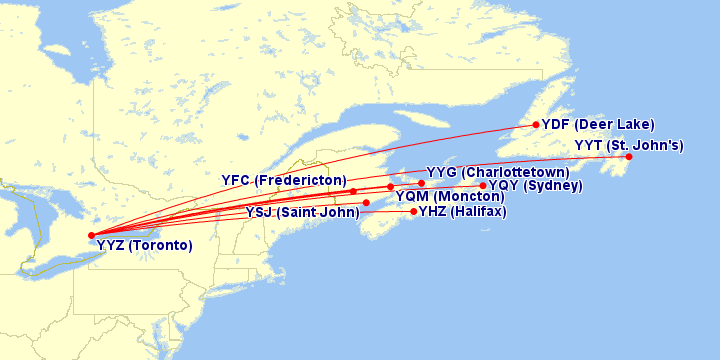
Flights to/from Montreal
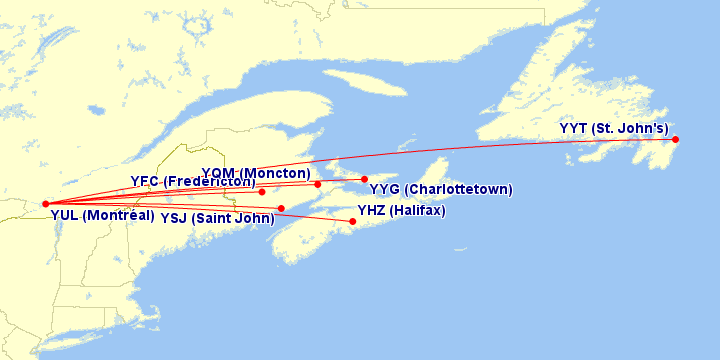
Flights to/from OTTAWA
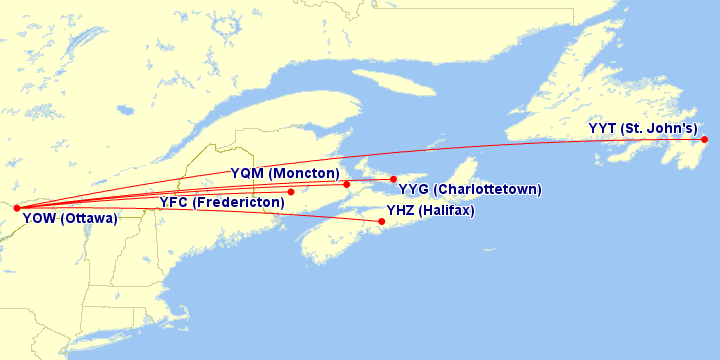
Flights to/from Calgary

That’s it. This means that besides the Calgary–Halifax route operated by Rouge, if you live anywhere other than Toronto, Montreal, or Ottawa, you’ll need to connect in one of those cities to even get to Atlantic Canada.
The Basic Trip
So now that we know the rules and the routes, let’s start putting the trip together. Since we are allowed one stopover in addition to the destination, something like this might work:
YVR–YYZ–YFC (stopover)
YFC–YHZ–YQY (destination)
YQY–YYZ–YVR
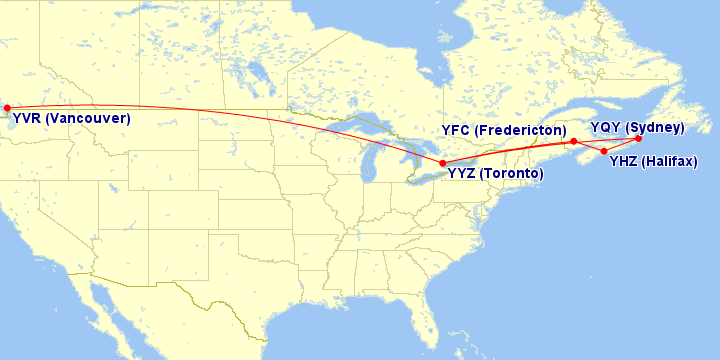
You get a stopover in Fredericton for as long as you want, and then you get to carry on to Sydney, Nova Scotia, and stay there for as long as you want as well.
All this will run you 25,000 miles, and regular airfare would probably cost over $1,000. That’s already incredible value. In Fredericton, you’re free to rent a car and drive a few hours to Prince Edward Island or Saint John or Moncton, in order to see more of the region.
This example presumes a Vancouver-based traveller, but it works the same way no matter where you’re based. One thing to note, though, is that if you live in Quebec, a similar trip (i.e., visiting New Brunswick and Nova Scotia in one go) would only cost 15,000 miles, since Quebec is lumped in with the Eastern provinces as “short-haul”. This also implies that Ottawans might find it worthwhile to drive to Montreal and start their journey there, to save 10,000 miles per person.
Supercharge Your Itinerary with Nested Tickets
Okay, you get to see the best of New Brunswick and visit Cape Breton, but what about the remnants of Viking culture in Newfoundland and the Inuit communities in Labrador?
Here’s the trick: since your first booking already takes you to Atlantic Canada – where you can stop for as long as you want in two places – you can now book another ticket within the region for just 15,000 miles, and get another stopover and another destination!
In our example, let’s “nest” the second ticket inside our Fredericton stopover. You’d book something like the below as your second ticket:
YFC–YHZ–YYT (destination)
YYT–YYR (stopover)
YYR–YHZ–YFC
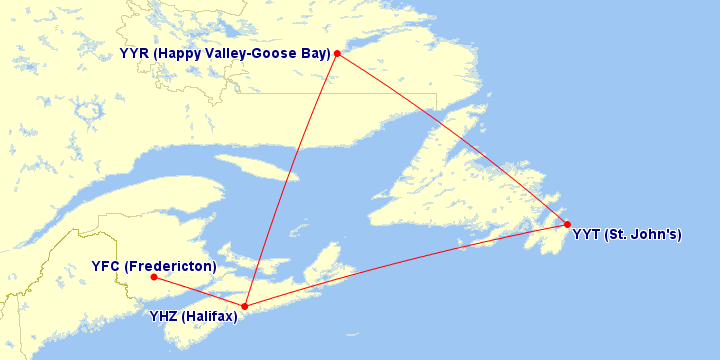
The above trip costs 15,000 miles, and a similar ticket booked in cash might be about $800. Again, spectacular value.
If we put it all together, our trip looks like this:
Ticket 1:
YVR–YYZ–YFC (stopover)
Ticket 2:
YFC–YHZ–YYT (destination)
YYT–YYR (stopover)
YYR–YHZ–YFC
YFC–YHZ–YQY (destination)
YQY–YYZ–YVR
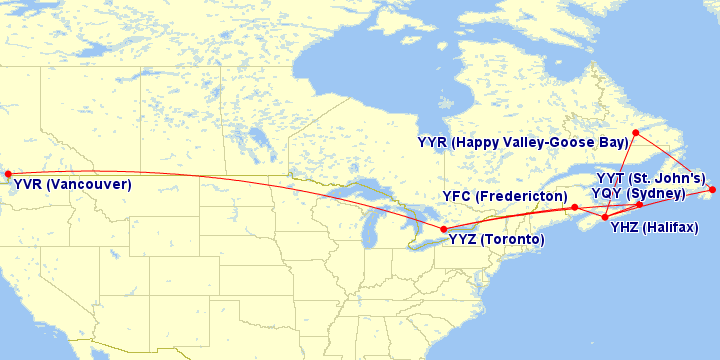
You end up getting to spend as much time as you wish in FOUR cities – in this example, it’s Fredericton (where you can rent a car and explore New Brunswick and PEI), St. John’s (where you can catch the view from Signal Hill, and perhaps do a side trip to Saint Pierre and Miquelon), Goose Bay (where the rest of Labrador is within your reach), and Sydney, Nova Scotia (where excellent whale-watching awaits).
All of this is available for only 40,000 Aeroplan miles (25,000 + 15,000) if you begin your journey anywhere in Canada or the US, or as little as 30,000 Aeroplan miles if you begin your journey in Quebec.
Best of all, you can play around with the idea on your own and come up with all sorts of itineraries. Want to skip New Brunswick? No problem, you can fly directly to PEI. Want to leave Labrador for next time and get more out of Newfoundland instead? Replace Goose Bay with Gander or Deer Lake.
A few caveats to keep in mind:
- You need to ensure that you don’t fall afoul of maximum permitted mileage (MPM) rules. Use the search engine trick to find out your MPM for your origin–destination pair (remember, the farthest stop from your origin counts as your destination). In our example, the MPM for YFC–YYT is 1,360 miles, and our return journey of YYT–YYR–YHZ–YFC comes in at 1,258, so we’re golden.
- You end up having to fly a few “unnecessary” flights. In our example, on your way back from Goose Bay, you can’t fly to Halifax and then go on to Sydney directly. You have to go back to Fredericton first to “finish” Ticket 2, then “resume” Ticket 1 from there, because if you miss the Ticket 1 flight, your whole ticket (including your flight back home!) gets cancelled. In any case, being forced to travel more is a small price to pay for booking a creative itinerary like this!
- You still have to pay airport improvement fees, taxes, etc., and in Canada these can add up quickly. And since this is Air Canada, there’s a handful of carrier surcharges as well. Compared to the cost of paying cash to hop around the region, though, it turns out to be a very reasonable outlay.
In this game we play, sometimes people get intimidated by “epic trips” that require hundreds of thousands of points to achieve. Well, this right here is a decidedly epic trip that every Canadian traveller can easily attain.
For instance, just by signing up for the American Express Business Gold Card and paying no annual fee for the first year, you’ll earn the 40,000 Aeroplan miles required to tour the Eastern provinces extensively.
What About Long Layovers?
While you are allowed unlimited layovers of up to 24 hours on international itineraries, the way it works for domestic tickets is a bit different. According to conventional wisdom, a “layover” on a domestic ticket is up to 4 hours between flights, with anything over 4 hours counting as a stopover. The exception is for overnight layovers, in which case catching the last flight in and the first flight out still counts as a layover.
In our example, we transit Halifax a bunch of times, but 4 hours wouldn’t really be enough to get to explore the city. But I wonder if you can leverage the overnight layover exception to get a longer layover. Indeed, a cursory dummy booking on Aeroplan throws up a few search results that give you a 10-hour layover in Halifax, so we know that layovers over 4 hours are indeed possible.
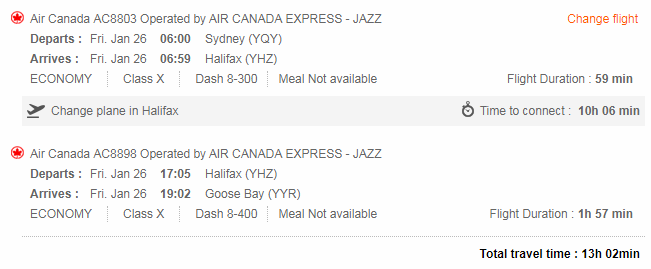
If you study Air Canada’s schedule, you might even be able to find situations where there’s only one flight coming in to Halifax from a certain city, and only one flight leaving Halifax to a different city, and the flights are timed so that there’s in fact 23 hours between arrival and departure. You’d probably have to book this over the phone, but this would allow you to squeeze out a 23-hour layover – and a fifth city to visit on your trip.
Anyway, this is all getting really complicated, so I’ll leave it to you to tinker with. Just know that it’s definitely possible to get some time in the city amidst all your connections via Halifax Stanfield International Airport – maybe enough time to see Peggy’s Cove!
Conclusion
Travelling to Atlantic Canada doesn’t have to break the bank! While it’s always tempting to pursue faraway lands on your vacations, there’s so much to see in our own backyard as well. By making the most of Aeroplan’s short-haul awards, you can really squeeze some insane value out of your points while heading out East very affordably.
Let me know if you have any questions in the comments, as well as any itineraries that you’re able to weave together on your own. I’m certainly looking to do this trip sometime relatively soon!




















Hi. I am new to the aeroplan world. I had to travel from yvr to mel and back several times in the last year. I have qualified for Silver status with 29,900 miles. Silver will be discontinued. I wish to travel to see relatives in st John’s Nfd. 1. Is the 25,000 points to redeem for a 1 way or return? 2. The flight shows 1 stop tho I don’t wish to stay over, I just want to get to nfd. Is that a problem? I find this all very complicated…
25,000 points is a round-trip long-haul flight within North America in economy class. If it shows a stop that you don’t want, that means the direct flight isn’t available on that date. Try searching for a different date or waiting to see if the direct flight opens up.
Great article! You’ve inspired me to plan a trip like this for my family.
I am wondering if this itinerary is ok, specifically the fact that I start from YHZ but have to fly through it on my way to YYT. (I also haven’t checked MPM yet, I’m on mobile)
Ticket 1
YYC – YOW (stopover)
YOW – YHZ. (Destination, Halifax.)
Ticket 2
YHZ – YFC (stopover Fredericton)
YFC – YHZ – YYT (dest, St. John’s)
YYT – YHZ
—— Back to ticket 1
YHZ – YYC
Thanks Ricky!
This could be an issue, since you aren’t allowed to route through the same city twice on either "side" of the destination. Right now you’re hitting YHZ twice on the outbound – once when you begin, once when you pass through.
Maybe try making YFC the destination of your Ticket 1 and then doing YFC-YHZ (stop)- YYT?
Thanks for the input, I wasn’t sure if where you started counted. I suppose I could do YFC as the destination but I would have to add a layover on the way home to YYC. Trying to minimize layovers since I’d be travelling with two kids under 6.
Really great tips in this post, Ricky. I’m curious, though: do you have any insights on how we could work this the other way around? I’m based in St. John’s, NL, and am having a bit of a challenge finding comparable value when trying to travel outside the Atlantic Canada region. This is true particularly because, as you’ve noted, Air Canada is effectively the only carrier that can be used.
Hi Justin,
You’d still be able to enjoy a destination + stopover within North America for 25,000 miles, which I imagine is decent value considering the cost of flights to/from NL.
If you wanted to explore multiple places within a region, you might be able to use short-haul roundtrips as a nested trip as well (for example, a 25K redemption to BC with a 15K redemption up to Yukon).
Hi Ricky,
Great post about routing options for this otherwise expensive regional travel. Getting in and out of Labrador is definitely pricey, and you can’t beat the value of 15,000 points from Montreal. Granted, sometimes it can be a bit of a hop. There are routes like Montreal-Sept Iles-Wabush-Goose Bay that can work if the usual Montreal-Halifax-Goose Bay is booked out. A word of caution when flying through St John’s – YYT often has weather delays, so Halifax can be a more reliable connection en route to Labrador. But maybe you can make the delay work for you!
Another option to consider is to terminate in Deer Lake. Then you do a one-way car rental from the airport and drive north through Gros Morne National Park to St Barbe, and take the ferry across to Labrador. Then it’s a 7-10 hour drive to Goose Bay along the South Coast Road, an adventure in itself. If you wanted to keep traveling north once in Goose Bay, you could take the Northern Ranger regional ferry (which has sleeper cabin options) right up to Nain, with a stop in every community along the way up and back down – only during shipping season, though, July-early Dec. Or there’s twin otter travel with Air Borealis (sadly not a Star Alliance member).
Erica
Excellent input, Erica. Thanks for that. I do hope to make it out to NL sometime soon!
What does YQ look like on this sort of itinerary?
Extremely reasonable when you compare to the price of cash fares. You’ll probably incur YQ of $100-200, plus some airport taxes and fees. Meanwhile booking these flights with cash can easily cost thousands of dollars.
Thanks for your insight, I really appreciate this kind of article. Also, perhaps you can talk about how to best redeem aeroplan if you are flying out from a smaller city such as Ottawa, Regina
Super useful post! Thanks!